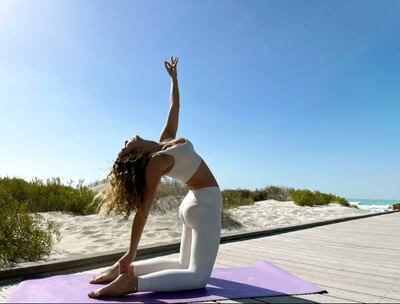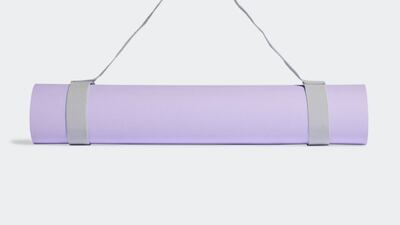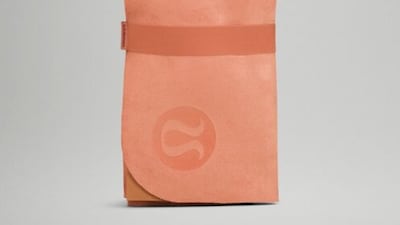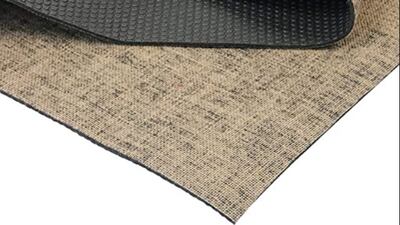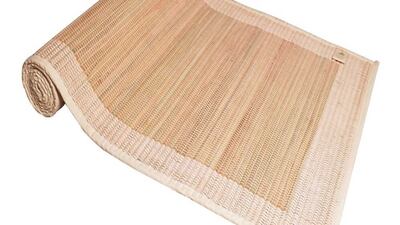With as many yoga mats on the market as there are yoga positions, it can be confusing to know which type to invest in.
To the untrained eye, most mats may look the same, but they differ in material, thickness, grip, size, weight and more, and choosing the right one is the best way to ensure you get the most out of your sessions. You also need to consider which variation of yoga you practise, the space you have available and any sensitivities or allergies to different materials.
“Buying a yoga mat is an important choice because it will support your practice, and help you enjoy it and get the best out of it,” says Angela Muller-Habig, yoga and Pilates instructor at Bodytree Studio in Abu Dhabi.
From rubber to cork, why materials matter
“Yoga mats are made from a variety of materials such as fibre-recyclable plastic, natural rubber, jute and cork,” says Shadi Enbashi, co-founder of Seva Holistic Wellness Centre in the UAE. “Fibre-recyclable plastic mats are environmentally friendly, provide excellent grip and are durable. Jute and cork mats are also eco-friendly and provide a good grip, but they may not be as durable as other materials.”
While PVC mats are the cheapest, they are also the most eco-unfriendly, and latex natural rubber mats are heavier and more expensive. Yoga mats were traditionally made of jute, which many practitioners prefer, and there are also biodegradable options.
“I own four mats, and choose among them according to the place where I practise yoga,” says Insiya Tinwala, a yoga instructor at Studio Sanjeev Krishna Yoga, Dubai. “Different materials have their own advantages and disadvantages. I wouldn’t want to use an expensive yoga mat on the beach, but rather a PVC cushioned mat, so I can have more grip and padding while holding postures.
“Cheaper mats are mostly made of artificial fibres and may have chemicals that are not good to breathe in when one lies on the stomach, so that’s when the cork mat is more beneficial.”
Different mats for different styles of yoga
Yoga mats vary in thickness to accommodate different types of yoga. Thinner mats are better suited for stability during active yoga disciplines such as ashtanga and vinyasa. Thicker mats provide extra cushioning and are designed for restorative, yin and hatha practices.
“If you’re looking for a more active style, you want a mat that is not super-thick, perhaps between 10mm and 35mm which will give you a bit of cushioning and enough stability to hold the more active poses and transition without feeling wobbly,” says Muller-Habig.
“If you have sensitive joints or you prefer a more restorative practice like yin, where you’ll be seated for longer periods of time, you might choose something more cushioned that provides more softness. However, it won’t be as stable if you’re balancing on one foot.”
When looking for a thicker mat, it’s recommended to spend more, as cheap materials will soften and thin out faster.
“Look out for the quality of materials used, durability, texture, thickness and size,” says Enbashi. “Expensive mats are often made with high-quality, sustainable materials that are more durable, and provide better grip and cushioning than cheaper mats.”
Tinwala adds: “If you are a beginner, I would suggest using a thicker mat as you are still learning how to balance, for which you need a better grip. Buy a textured mat made of PVC for better support and balance as it is also pocket-friendly.”
Mat maintenance
As with most exercise equipment, yoga mats needed to be cleaned, cared for and maintained, especially by practitioners who perspire a lot during sessions.
“Latex rubber is a premium mat and will last several years as long as you care for it properly. You can buy special cleaners for your mat, or clean it in the bathtub using a very mild soap before rinsing it well,” says Muller-Habig. “Let it dry in the shade, so the rubber doesn’t deteriorate.”
Yogis who wish to practise while on holiday or work trips can invest in a travel mat that packs up smaller and thinner to fit in a suitcase or carry-on.
“Ideally, if you are an avid yoga practitioner, you should have two yoga mats, a thicker one for regular practice at home, and a thinner one for travelling around,” says Enbashi.
Muller-Habig adds: “Travel yoga mats are usually made of latex rubber. I love this style as you can fold it like a carpet and take it everywhere with you.”
Expert input
If you had all the money in the world, what’s the one sneaker you would buy or create?
“There are a few shoes that have ‘grail’ status for me. But the one I have always wanted is the Nike x Patta x Parra Air Max 1 - Cherrywood. To get a pair in my size brand new is would cost me between Dh8,000 and Dh 10,000.” Jack Brett
“If I had all the money, I would approach Nike and ask them to do my own Air Force 1, that’s one of my dreams.” Yaseen Benchouche
“There’s nothing out there yet that I’d pay an insane amount for, but I’d love to create my own shoe with Tinker Hatfield and Jordan.” Joshua Cox
“I think I’d buy a defunct footwear brand; I’d like the challenge of reinterpreting a brand’s history and changing options.” Kris Balerite
“I’d stir up a creative collaboration with designers Martin Margiela of the mixed patchwork sneakers, and Yohji Yamamoto.” Hussain Moloobhoy
“If I had all the money in the world, I’d live somewhere where I’d never have to wear shoes again.” Raj Malhotra
Monster Hunter: World
Capcom
PlayStation 4, Xbox One
GAC GS8 Specs
Engine: 2.0-litre 4cyl turbo
Power: 248hp at 5,200rpm
Torque: 400Nm at 1,750-4,000rpm
Transmission: 8-speed auto
Fuel consumption: 9.1L/100km
On sale: Now
Price: From Dh149,900
Ferrari 12Cilindri specs
Engine: naturally aspirated 6.5-liter V12
Power: 819hp
Torque: 678Nm at 7,250rpm
Price: From Dh1,700,000
Available: Now
MO
%3Cp%3E%3Cstrong%3ECreators%3A%20%3C%2Fstrong%3EMohammed%20Amer%2C%20Ramy%20Youssef%3C%2Fp%3E%0A%3Cp%3E%3Cstrong%3EStars%3A%20%3C%2Fstrong%3EMohammed%20Amer%2C%20Teresa%20Ruiz%2C%20Omar%20Elba%3C%2Fp%3E%0A%3Cp%3E%3Cstrong%3ERating%3A%3C%2Fstrong%3E%204%2F5%3C%2Fp%3E%0A
SERIES INFO
Afghanistan v Zimbabwe, Abu Dhabi Sunshine Series
All matches at the Zayed Cricket Stadium, Abu Dhabi
Test series
1st Test: Zimbabwe beat Afghanistan by 10 wickets
2nd Test: Wednesday, 10 March – Sunday, 14 March
Play starts at 9.30am
T20 series
1st T20I: Wednesday, 17 March
2nd T20I: Friday, 19 March
3rd T20I: Saturday, 20 March
TV
Supporters in the UAE can watch the matches on the Rabbithole channel on YouTube
SPEC%20SHEET%3A%20APPLE%20TV%204K%20(THIRD%20GENERATION)
%3Cp%3E%3Cstrong%3ECPU%3A%3C%2Fstrong%3E%20Apple%20A15%20Bionic%3C%2Fp%3E%0A%3Cp%3E%3Cstrong%3ECapacity%3A%3C%2Fstrong%3E%2064GB%2C%20Wi-Fi%20only%3B%20128GB%2C%20Wi-Fi%20%2B%20ethernet%3C%2Fp%3E%0A%3Cp%3E%3Cstrong%3EConnectivity%3A%3C%2Fstrong%3E%20Wi-Fi%206%2C%20Bluetooth%205.0%2C%20ethernet%20(Wi-Fi%20%2B%20ethernet%20model%20only)%2C%20IR%20receiver%3C%2Fp%3E%0A%3Cp%3E%3Cstrong%3EI%2FO%3A%3C%2Fstrong%3E%20HDMI%2C%20ethernet%20(128GB%20model%20only)%3B%20Siri%20remote%20(charging%20via%20USB-C)%3B%20accessibility%20features%3C%2Fp%3E%0A%3Cp%3E%3Cstrong%3EVideo%3A%3C%2Fstrong%3E%20SDR%2FDolby%20Vision%2FHDR10%2B%20up%20to%202160p%20%40%2060fps%3C%2Fp%3E%0A%3Cp%3E%3Cstrong%3EPeripherals%3A%3C%2Fstrong%3E%20Compatible%20with%20HD%2FUHD%20TVs%20via%20HDMI%2C%20Bluetooth%20keyboards%2C%20AirPods%3C%2Fp%3E%0A%3Cp%3E%3Cstrong%3EPhoto%3A%3C%2Fstrong%3E%20GIF%2C%20HEIF%2C%20JPEG%2C%20TIFF%3C%2Fp%3E%0A%3Cp%3E%3Cstrong%3EColour%3A%3C%2Fstrong%3E%20Black%3C%2Fp%3E%0A%3Cp%3E%3Cstrong%3EIn%20the%20box%3A%3C%2Fstrong%3E%20TV%204K%2C%20Siri%20remote%2C%20power%20cord%3C%2Fp%3E%0A%3Cp%3E%3Cstrong%3EPrice%3A%3C%2Fstrong%3E%20Dh529%2C%20Wi-Fi%20only%3B%20Dh599%2C%20Wi-Fi%20%2B%20ethernet%3C%2Fp%3E%0A
Top%2010%20most%20competitive%20economies
%3Cp%3E1.%20Singapore%0D%3Cbr%3E2.%20Switzerland%0D%3Cbr%3E3.%20Denmark%0D%3Cbr%3E4.%20Ireland%0D%3Cbr%3E5.%20Hong%20Kong%0D%3Cbr%3E6.%20Sweden%0D%3Cbr%3E7.%20UAE%0D%3Cbr%3E8.%20Taiwan%0D%3Cbr%3E9.%20Netherlands%0D%3Cbr%3E10.%20Norway%0D%3Cbr%3E%3C%2Fp%3E%0A
The%20Woman%20King%20
%3Cp%3E%3Cstrong%3EDirector%3A%3C%2Fstrong%3E%20Gina%20Prince-Bythewood%3C%2Fp%3E%0A%3Cp%3E%3Cstrong%3EStars%3A%3C%2Fstrong%3E%20Viola%20Davis%2C%20Thuso%20Mbedu%2C%20Sheila%20Atim%2C%20Lashana%20Lynch%2C%20John%20Boyega%C2%A0%3C%2Fp%3E%0A%3Cp%3E%3Cstrong%3ERating%3A%3C%2Fstrong%3E%203%2F5%3C%2Fp%3E%0A
How to apply for a drone permit
- Individuals must register on UAE Drone app or website using their UAE Pass
- Add all their personal details, including name, nationality, passport number, Emiratis ID, email and phone number
- Upload the training certificate from a centre accredited by the GCAA
- Submit their request
What are the regulations?
- Fly it within visual line of sight
- Never over populated areas
- Ensure maximum flying height of 400 feet (122 metres) above ground level is not crossed
- Users must avoid flying over restricted areas listed on the UAE Drone app
- Only fly the drone during the day, and never at night
- Should have a live feed of the drone flight
- Drones must weigh 5 kg or less
COMPANY PROFILE
Founders: Sebastian Stefan, Sebastian Morar and Claudia Pacurar
Based: Dubai, UAE
Founded: 2014
Number of employees: 36
Sector: Logistics
Raised: $2.5 million
Investors: DP World, Prime Venture Partners and family offices in Saudi Arabia and the UAE
The specs
Engine: 4.0-litre flat-six
Torque: 450Nm at 6,100rpm
Transmission: 7-speed PDK auto or 6-speed manual
Fuel economy, combined: 13.8L/100km
On sale: Available to order now
Islamophobia definition
A widely accepted definition was made by the All Party Parliamentary Group on British Muslims in 2019: “Islamophobia is rooted in racism and is a type of racism that targets expressions of Muslimness or perceived Muslimness.” It further defines it as “inciting hatred or violence against Muslims”.
Boulder shooting victims
• Denny Strong, 20
• Neven Stanisic, 23
• Rikki Olds, 25
• Tralona Bartkowiak, 49
• Suzanne Fountain, 59
• Teri Leiker, 51
• Eric Talley, 51
• Kevin Mahoney, 61
• Lynn Murray, 62
• Jody Waters, 65
Left Bank: Art, Passion and Rebirth of Paris 1940-1950
Agnes Poirer, Bloomsbury
The Bio
Favourite place in UAE: Al Rams pearling village
What one book should everyone read: Any book written before electricity was invented. When a writer willingly worked under candlelight, you know he/she had a real passion for their craft
Your favourite type of pearl: All of them. No pearl looks the same and each carries its own unique characteristics, like humans
Best time to swim in the sea: When there is enough light to see beneath the surface
Day 5, Dubai Test: At a glance
Moment of the day Given the problems Sri Lanka have had in recent times, it was apt the winning catch was taken by Dinesh Chandimal. He is one of seven different captains Sri Lanka have had in just the past two years. He leads in understated fashion, but by example. His century in the first innings of this series set the shock win in motion.
Stat of the day This was the ninth Test Pakistan have lost in their past 11 matches, a run that started when they lost the final match of their three-Test series against West Indies in Sharjah last year. They have not drawn a match in almost two years and 19 matches, since they were held by England at the Zayed Cricket Stadium in Abu Dhabi in 2015.
The verdict Mickey Arthur basically acknowledged he had erred by basing Pakistan’s gameplan around three seam bowlers and asking for pitches with plenty of grass in Abu Dhabi and Sharjah. Why would Pakistan want to change the method that has treated them so well on these grounds in the past 10 years? It is unlikely Misbah-ul-Haq would have made the same mistake.
SPECS
%3Cp%3E%3Cstrong%3EEngine%3A%3C%2Fstrong%3E%202-litre%204-cylinder%20turbo%0D%3Cbr%3E%3Cstrong%3EPower%3A%20%3C%2Fstrong%3E268hp%0D%3Cbr%3E%3Cstrong%3ETorque%3A%20%3C%2Fstrong%3E380Nm%0D%3Cbr%3E%3Cstrong%3EPrice%3A%20%3C%2Fstrong%3EFrom%20Dh208%2C000%0D%3Cbr%3E%3Cstrong%3EOn%20sale%3A%20%3C%2Fstrong%3ENow%0D%3Cbr%3E%3C%2Fp%3E%0A
MATCH INFO
Red Star Belgrade v Tottenham Hotspur, midnight (Thursday), UAE
COMPANY%20PROFILE
%3Cp%3ECompany%20name%3A%20CarbonSifr%3Cbr%3EStarted%3A%202022%3Cbr%3EBased%3A%20Dubai%3Cbr%3EFounders%3A%20Onur%20Elgun%2C%20Mustafa%20Bosca%20and%20Muhammed%20Yildirim%3Cbr%3ESector%3A%20Climate%20tech%3Cbr%3EInvestment%20stage%3A%20%241%20million%20raised%20in%20seed%20funding%3Cbr%3E%3C%2Fp%3E%0A
The specs
Engine: 1.4-litre 4-cylinder turbo
Power: 180hp at 5,500rpm
Torque: 250Nm at 3,00rpm
Transmission: 5-speed sequential auto
Price: From Dh139,995
On sale: now
MATCH INFO
Who: France v Italy
When: Friday, 11pm (UAE)
TV: BeIN Sports
Stats at a glance:
Cost: 1.05 billion pounds (Dh 4.8 billion)
Number in service: 6
Complement 191 (space for up to 285)
Top speed: over 32 knots
Range: Over 7,000 nautical miles
Length 152.4 m
Displacement: 8,700 tonnes
Beam: 21.2 m
Draught: 7.4 m

